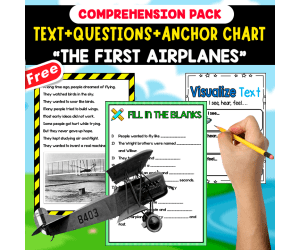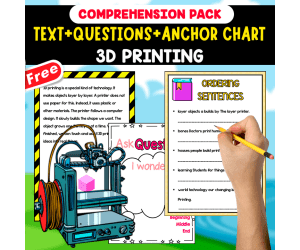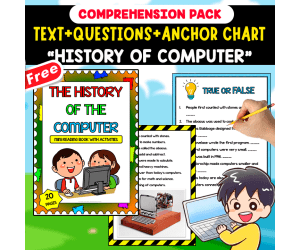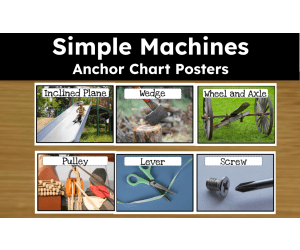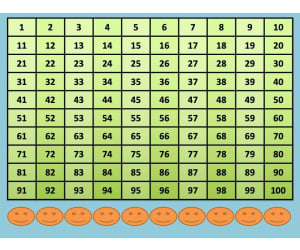2,423 products added recently
Science Charts
Science Charts cover a wide range of topics, from the periodic table to the water cycle, offering visual representations that simplify complex ideas. By incorporating science charts into your classroom, you make abstract concepts more accessible and engage students in interactive learning.
READING-COMPREHENSION PACK | ROBOTICS | 20 PAGES
Reading Comprehension, Reading, ELA, Strategies, Creative Writing, Writing, Technology, Science, Computer Science, Engineering, Adult Education, Elementary, High School, Homeschool Resources, Middle School, Not Grade Specific, Anchor Charts, Teacher Tools, Assessments, Charts, Quizzes and Tests
READING-COMPREHENSION PACK | ROBOTICS | 20 PAGES SUMMARY OF THIS PRODUCT: What is the name of the document?: READING AND COMPREHENSION ABOUT ROBOTICS How many pages does it include?: 20 In what format is it available (PDF, Word, PPT)?: PDF Is it in color or black and white?: COLOR ABOUT THE AUTHOR: Hi there! We are EDITORIAL ARENAS EDUCATIVAS 🎓✨. We love designing educational materials that make children’s learning joyful, dynamic, and motivating. I invite you to visit my educational store, explore the variety of resources available, and find the perfect one for your students. MAIN DESCRIPTION OF THIS PRODUCT: What is the full title of the product? This fabulous educational resource is titled: READING AND COMPREHENSION ABOUT ROBOTICS How many pages or items does it include in total? This educational compilation contains the following number of pages: 20 What format is it in (digital, printable, PDF, A4, letter)? This fun and engaging resource is designed in A4 format and has been converted to PDF, making it easy to use and carry anywhere. PDF A4 Is the design in full color, black and white, or mixed? This document includes both black and white and color versions, making it more creative and appealing. You also have the freedom to print it in whichever style you prefer. COLOR SECONDARY AND COMPLEMENTARY INFORMATION: What learning area does it focus on? This and all my resources focus on children’s essential learning, such as math and literacy. Occasionally, I also create resources for Spanish. What will students learn or practice with it? With this educational resource, children will be able to practice basic skills in math and literacy. Teachers can also adapt it to other learning areas, since learning is multidisciplinary. Who will benefit the most from this resource (teachers, families, students, therapists)? I strongly believe education involves many people—teachers, parents, and even therapists. That’s why this resource is open to anyone involved in the learning process.
Author EDITORIAL LAURA EDUCA
Rating
Tags FREE, FREE RESOURCES, TOP RESOURCES, READING, READING AND COMPREHENSION, COMPREHENSION, ROBOTICS
READING-COMPREHENSION PACK | THE FIRST AIRPLANES | 20 PAGES
Reading, ELA, Writing, Technology, Science, Adult Education, Elementary, High School, Homeschool Resources, Middle School, Not Grade Specific, Anchor Charts, Teacher Tools, Assessments, Charts, Graphic Organizers, Quizzes and Tests
READING-COMPREHENSION PACK | THE FIRST AIRPLANES | 20 PAGES SUMMARY OF THIS PRODUCT: The name of the document: READING-COMPREHENSION PACK | THE FIRST AIRPLANES The total number of pages: 20 The format (PDF, Word, PPT): PDF Whether it is in color or black and White: COLOR ABOUT THE AUTHOR: At EDITORIAL ARENAS EDUCATIVAS, we specialize in designing high-quality educational materials. We want every child to discover that learning can be both entertaining and creative. I invite you to explore my educational store and discover the wide collection of resources available for your classroom or home. MAIN DESCRIPTION: What is the name of your product and what makes it special? This beautiful product is called “READING-COMPREHENSION PACK | THE FIRST AIRPLANES", and it is very special because it was carefully designed or compiled. With this educational resource, we want students to learn with enthusiasm and fun, because we believe learning is fun. How many pages are included in this resource? This fabulous document contains the following number of pages: 20 What size is it designed in (A4, letter, etc.)? This resource is designed in A4 format and compiled as a PDF. This makes downloading and printing simple and convenient, and PDFs are also easy to store and carry anywhere. PDF A4 Is the material in color or black and white? This pedagogical document comes in both black and white and color. This makes it more attractive for your learning sessions, but you have the freedom to choose how to print it. COLOR SECONDARY AND COMPLEMENTARY INFORMATION: What type of material is it (book, workbook, activity pack, posters, flashcards)? EDITORIAL ARENAS EDUCATIVAS creates a variety of materials such as packs, worksheets, games, and assessments. This resource belongs to one of those categories. For what ages, levels, or grades is it designed? My specialty is creating educational resources for children, especially for preschool (ages 3–5) and primary (ages 6–12). Sometimes, I also create Spanish resources for learners of all ages. What subject, skill, or topic does it cover? This resource is designed to cover essential learning areas for children, generally literacy and math. What learning objectives does it achieve? This document fulfills a playful objective—it’s meant to be attractive and engaging for children. At the same time, it ensures that students learn or reinforce their knowledge.
Author EDITORIAL LAURA EDUCA
Rating
Tags FREE, FREE RESOURCES, READING, COMPREHENSION, AIRPLANES, HISTORY, ANCHOR CHART
READING-COMPREHENSION TEXT | 3D PRINTING | 20 FREE PAGES
ELA, Reading, Writing, Language Development, Technology, Science, Adult Education, Elementary, High School, Homeschool Resources, Middle School, Not Grade Specific, Assessments, Teacher Tools, Anchor Charts, Charts, Quizzes and Tests
READING-COMPREHENSION TEXT | 3D PRINTING | 20 FREE PAGES SUMMARY OF THIS PRODUCT: What is the name of the document?: READING-COMPREHENSION TEXT | 3D PRINTING How many pages does it include?: 20 In what format is it available (PDF, Word, PPT)?: PDF Is it in color or black and white?: COLOR ABOUT THE AUTHOR: Hi there! We are EDITORIAL ARENAS EDUCATIVAS 🎓✨. We love designing educational materials that make children’s learning joyful, dynamic, and motivating. I invite you to visit my educational store, explore the variety of resources available, and find the perfect one for your students. MAIN DESCRIPTION OF THIS PACK: What is the full title of the product? This fabulous educational resource is titled: READING-COMPREHENSION TEXT | 3D PRINTING How many pages or items does it include in total? This educational compilation contains the following number of pages: 20 What format is it in (digital, printable, PDF, A4, letter)? This fun and engaging resource is designed in A4 format and has been converted to PDF, making it easy to use and carry anywhere. PDF Is the design in full color, black and white, or mixed? This document includes both black and white and color versions, making it more creative and appealing. You also have the freedom to print it in whichever style you prefer. COLOR THANK YOU SO MUCH FOR PREFERRING MY PRODUCTS! SECONDARY AND COMPLEMENTARY INFORMATION: What subject or area does it cover? This educational document covers basic knowledge areas all students should have, such as math and literacy. What skills or competencies does it develop? Thanks to this fabulous resource, students will first be able to develop their knowledge, attention, and concentration. Who can use it (teachers, parents, therapists, students)? This document can be adapted according to the person using it. If you’re a teacher, you can use it; if you do homeschooling, you can also use it. Therapists can use it for students with learning difficulties, and even self-learners will find it very useful.
Author EDITORIAL LAURA EDUCA
Rating
Tags FREE, FREE RESOURCES, 3D PRINTING, TECHNOLOGY, READING, READING AND COMPREHENSION, COMPREHENSION, ELA
Material vs Non-Material Culture with Acadian Culture Reading Passage and T-Charts
Social Studies, ELA, History, History: Canada, Reading, Reading Comprehension, Science, Earth and Environmental Sciences, Life Sciences, Nature & Plants, Grade 5, 6, 7, 8, Charts, Teacher Tools
This middle school social studies lesson has three parts to help teach your students the difference between material and non-material culture. 1) An introduction to the concept of material vs. non-material culture 2) A one-page reading about Acadian culture. Students will sort the parts of this culture in a T-chart. 3) A second T-chart for students to sort the material and non-material aspects of their own culture. How to Use: Teach your students the difference between material and non-material culture. Culture is the set of values, ideas, traditions, and objects that a group passes from one generation to the next. It can be divided into two categories: Material: physical objects, books, art, structures, clothing, technology Non-Material: ideas/values/things that can’t be seen, language, religion, customs, rules, education, government Brainstorm aspects of culture on the board and sort them into the two categories. Students read the one-page passage about Acadian culture and sort the parts that are material and non-material onto their T-chart. They could do this independently or in small groups. Share the results as a class. Notice if any parts of culture are hard to categorize in this way. Then students think about their own culture and sort aspects of it into material and non-material culture. This could become the basis for a paragraph or short essay assignment. Grades to Use With: This assignment is designed for students in the middle grades (5-8) or high school special education classrooms. Standards: CCSSW.5.8 Recall relevant information from experiences or gather relevant information from print and digital sources; summarize or paraphrase information in notes and finished work, and provide a list of sources. If you like this product, check out my store for other middle grades science, math, and language arts assignments! Grace Under Pressure
Author Grace Under Pressure
Tags Culture, Social Studies, Acadian, Reading Passage, T-chart, Material Culture, Non-material Culture, Traditions, Canadian History, Maritimes, Non Material Vs Material Culture, What Is The Difference Between Material And Non-material Culture?, Material Vs Non Material, Difference Between Material And Non-material Culture, Material And Non Material Culture, Material Culture Vs Non Material Culture
Butterfly Life Cycle Chart
Insects, Life Sciences, Science, Nature & Plants, Kindergarten, Grade 1, 2, Posters, Classroom Decor, Charts, Teacher Tools, Diagrams, Coloring Pages, Worksheets, Worksheets & Printables
Here is a beautiful, simple Butterfly Life Cycle Chart, with a black and white version, to brighten your classroom and make children want to ask questions and learn! Children love butterflies, so this chart is sure to please! Children will love to colour their own chart! This chart has simple pictures for the non-readers in your class, as well as labels to encourage reading. Uses for the Butterfly Life Cycle Chart: Use as part of a butterfly kindergarten science project. It is included in this pack Give a chart to each group of children on their desk to help them with their project/science writing. Use it as a poster as part of a display Use it as a visual aid for a lesson, which can be followed up with workheets. (included in this pack) Use it to compare the life cycles of various creatures Who is the Butterfly Life Cycle Chart for? The Butterfly Life Cycle Chart is for all: parents teachers classroom assistants Ages of use: The Butterfly Life Cycle Chart can be used with all ages Suggested tip It is advised that you laminate the chart to make it durable. What is included? 1 colour, A4 Butterfly Life Cycle Chart 1 black and white Butterfly Life Cycle Chart Worksheets and lesson outlines for a project to accompany this chart can be found here: https://teachsimple.com/product/butterflies-mini-thematic-unit-plan Butterflies are a good way to teach pupils about life cycles - the children see them in their environment, and they can easily lead to scientific research and learning. Stimulate the asking of questions: Do the colors of caterpillars indicate the colors of the adult butterfly? Are all caterpillars the same size? Do they shed their skins? Which other creatures do we know of that shed their skins? Can we tell by the leaf we find eggs on which kind of butterfly laid them?
Author Lilibette's Resources
Rating
Tags Butterfly Life Cycle, Life Cycles, Life Cycle Chart, Insects, Nature, Life Cycle Diagram, Life Cycle Diagrams, Butterflies, Science Coloring Pages
READING-COMPREHENSION PACK | Artificial Intelligence | 20 PAGES
Reading, ELA, Writing, Technology, Science, Early Learning, Adult Education, High School, Homeschool Resources, Middle School, Not Grade Specific, Anchor Charts, Teacher Tools, Assessments, Charts, Quizzes and Tests
READING-COMPREHENSION PACK | Artificial Intelligence | 20 PAGES SUMMARY OF THIS PRODUCT: What is the name of the document?: READING-COMPREHENSION PACK | Artificial Intelligence How many pages does it include?: 20 In what format is it available (PDF, Word, PPT)?: PDF Is it in color or black and white?: COLOR ABOUT THE AUTHOR: At EDITORIAL ARENAS EDUCATIVAS, we believe that learning should be as fun as playing. That’s why we create educational materials that spark children’s curiosity and creativity. I invite you to check out my educational store and discover the wide range of resources that can transform your classes. MAIN DESCRIPTION: What is the name of the product? Hello! Thank you so much for being interested in this beautiful and fabulous product that you can use with your children, both at school and at home. The name of this fabulous product is: READING-COMPREHENSION PACK | Artificial Intelligence How many pages does it include? This educational document, carefully created and in some cases compiled, has the following number of pages: 20 What format is it in (A4, letter, digital, printable)? This educational resource is designed in A4 format and PDF, so you will have no difficulties printing it and it will also stay well-protected. PDF A4 Is it in black and white or in color? This document is available in black and white as well as in color. Actually, it combines both, making it more attractive for your students. COLOR SECONDARY AND COMPLEMENTARY INFORMATION: For what age, grade, or school level is it ideal? I usually create resources for early grades (children ages 3–5), but I also design for primary students (ages 7–12). My priority is to make children’s learning creative. What learning area does it focus on? This and all my resources focus on children’s essential learning, such as math and literacy. Occasionally, I also create resources for Spanish. What will students learn or practice with it? With this educational resource, children will be able to practice basic skills in math and literacy. Teachers can also adapt it to other learning areas, since learning is multidisciplinary. Who will benefit the most from this resource (teachers, families, students, therapists)? I strongly believe education involves many people—teachers, parents, and even therapists. That’s why this resource is open to anyone involved in the learning process.
Author EDITORIAL LAURA EDUCA
Rating
Tags FREE, FREE RESOURCES, READING, TECHONOLGY, ARTIFICIAL INTELLIGENCE, READING AND COMPREHENSION, COMPREHENSION
READING-COMPREHENSION PACK | HISTORY OF COMPUTER | 20 FREE PAGES
Reading, ELA, Writing, Technology, Science, Computer Science, Adult Education, Elementary, High School, Homeschool Resources, Middle School, Not Grade Specific, Anchor Charts, Teacher Tools, Assessments, Charts, Diagrams, Quizzes and Tests
READING-COMPREHENSION PACK | HISTORY OF COMPUTER | 20 FREE PAGES SUMMARY OF THIS PRODUCT: · Document Title: READING-COMPREHENSION PACK | HISTORY OF COMPUTER · Number of Pages: 20 · File Format (PDF, Word, PPT): PDF · Color or Black & White: COLOR MAIN DESCRIPTION OF THIS PACK: What is the full title of the product? This fabulous educational resource is titled: READING-COMPREHENSION PACK | HISTORY OF COMPUTER How many pages or items does it include in total? This educational compilation contains the following number of pages: 20 What format is it in (digital, printable, PDF, A4, letter)? This fun and engaging resource is designed in A4 format and has been converted to PDF, making it easy to use and carry anywhere. PDF A4 Is the design in full color, black and white, or mixed? This document includes both black and white and color versions, making it more creative and appealing. You also have the freedom to print it in whichever style you prefer. COLOR ABOUT THE AUTHOR: Hi there! We are EDITORIAL ARENAS EDUCATIVAS 🎓✨. We love designing educational materials that make children’s learning joyful, dynamic, and motivating. I invite you to visit my educational store, explore the variety of resources available, and find the perfect one for your students. EXTRA INFORMATION OF THIS PRODUCT: What will students learn or practice with it? With this educational resource, children will be able to practice basic skills in math and literacy. Teachers can also adapt it to other learning areas, since learning is multidisciplinary. Who will benefit the most from this resource (teachers, families, students, therapists)? I strongly believe education involves many people—teachers, parents, and even therapists. That’s why this resource is open to anyone involved in the learning process. Is any additional material needed to work with it? Sometimes yes, such as pencils, crayons, markers, and scissors. It all depends on how deeply you want your students to engage with the activities. What is the main value or advantage of this resource compared to others? The main advantage is that it captures children’s attention. It also makes students believe learning is fun. With this worksheet, your students will strengthen their knowledge and skills.
Author EDITORIAL LAURA EDUCA
Rating
Tags FREE, FREE RESOURCES, ANCHOR CHART, READING, READING AND COMPREHENSION, COMPREHENSION, COMPUTER
Simple Machines Posters (Anchor Charts)
Physics, Science, STEM, Elementary, Middle School, Pre-K, Anchor Charts, Teacher Tools, Charts
Colorful and bright posters to display 6 Simple Machines! Easy to print and display. Posters Included Are: Inclined Plane Wedge Wheel and Axle Pulley Lever Screw File comes as a PDF of 7 pages. Pages 1-6 each feature one simple machine listed above. Page 7 features all of the 6 simple machines on one sheet. These pages can be printed on 8.5" x 11" paper or bigger A3 size paper for larger posters. Real photographs are used to help students understand each simple machine in real-life context. These posters are ideal for various grade levels (pre-K through middle school). - - - - - - - - - - - - - - - - - - - - - - - - - - - - - - - - - - - - - - - - - - - - - - - - - - - - - - - - - - - - - - - - - - - - - - - - - - - - - - - - I hope you enjoy! - - - - - - - - - - - - - - - - - - - - - - - - - - - - - - - - - - - - - - - - - - - - - - - - - - - - - - - - - - - - - - - - - - - - - - - - - - - - - - - - - - - - - - - - - - - - - - - - - - - - - - - - - - - - - - - - - - - - - -
Author CraftEdPrints
Rating
Tags Simplemachines, Science, Physicalscience
Smartboard Number Chart
Math, Numbers, Science, Technology, Preschool, Kindergarten, Grade 1, Charts, Teacher Tools
Smartboard Number Chart
Author Have Fun Teaching
Tags Have Fun Teaching, Place Value Smartboard Games, Interactive Hundred Chart Smartboard
What's the Weather? Spinner and Chart
Science, Earth and Environmental Sciences, Environmental Science, Preschool, Kindergarten, Grade 1, 2, Charts, Teacher Tools
What's the Weather? Spinner and Chart This useful weather chart set can enhance elementary science lessons on meteorology. The set contains a spin wheel and graphing chart displaying common weather types like sunny, cloudy, rainy, snowy, windy, stormy, hot, and cold. Teachers can utilize the colorful spin wheel for morning meetings. Allow a student to spin the wheel and report the resulting weather type. Classmates can then graph the result on the included blank chart. Over time, students will collect real-time weather data and practice graph interpretation skills. The spin wheel also promotes predictions, estimations, and discussions about weather patterns. Alternatively, display the wheel on a science bulletin board for students to interact with. Pair it with student-made weather journals or forecasts for immersive meteorology activities. With its versatile use cases, this weather chart set engages K-2 learners on core science topics.
Author Kindergarten Cafe
Tags Weather Chart, Science Chart, Weather Activity, Bulletin Board, Weather Spinner, Chart Spinner
What's the Weather? Spinner and Chart | Black Neon Design
Science, Earth and Environmental Sciences, Environmental Science, Preschool, Kindergarten, Grade 1, 2, Charts, Teacher Tools
What's the Weather? Spinner and Chart is a teaching resource that focuses on weather concepts for elementary school students. This printable PDF includes two components - a circle spinner chart and a blank graphing chart with a chalkboard theme. Teachers can utilize the spinner chart for students to make daily weather predictions. The blank chart allows students to track and graph weather patterns each month by shading in the type of weather for each day. These hands-on activities promote critical thinking, data analysis, and real-world connections for Kindergarten to 2nd grade students. This weather unit resource enables small group collaboration, whole class instruction, individual practice, and homework assignments. By incorporating interactive visuals and student-driven recording into science lessons, students gain a deeper understanding of meteorology while building valuable life skills. The black and neon chalkboard design adds an engaging element for early elementary students.
Author Kindergarten Cafe
Tags Weather, Chart, Spinner, Sunny, Cloudy







































